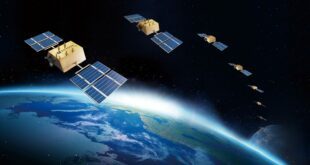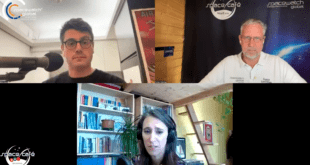by Blaine Curcio and Jean Deville
 As part of the partnership between SpaceWatch.Global and Orbital Gateway Consulting we have been granted permission to publish selected articles and texts. We are pleased to present “Dongfang Hour China Aerospace News Roundup 27 September – 3 October 2021”.
As part of the partnership between SpaceWatch.Global and Orbital Gateway Consulting we have been granted permission to publish selected articles and texts. We are pleased to present “Dongfang Hour China Aerospace News Roundup 27 September – 3 October 2021”.
Hello and welcome to another episode of the Dongfang Hour China Aero/Space News Roundup! A special shout-out to our friends at GoTaikonauts!, and at SpaceWatch.Global, both excellent sources of space industry news. In particular, we suggest checking out GoTaikonauts! long-form China reporting, as well as the Space Cafe series from SpaceWatch.Global. Without further ado, the news update from the week of 27 September – 3 October 2021.
1) The Zhuhai Airshow, the new epicenter for the Chinese space industry?
Jean’s Take
The 13th edition of the Zhuhai Air Show was held in the south China metropolis of Zhuhai from 28/09 to 03/10, where we saw a very significant number of space updates and insights into China’s future space program.
This is rather unexpected as the air show, held since 1996, has mainly been a hot place for civil and military aviation. I remember going to the exhibition in 2018, and seeing only one NewSpace company (iSpace), even if there were quite a few SoE as well. This year however, it seems like the entire space elite is there, with dozens and dozens of commercial space companies having stands. Probably related to this growth, the Airshow expanded the number of exhibition halls from 8 (in 2018) to 11 (in 2021).
Let’s go over some of the main announcements:
- First display of China’s MEV: First of all, China’s first Mission Extension Vehicle (MEV) was revealed to the public for the first time. MEVs are really a new type of spacecraft to hit the market, with the only operational service currently coming from Northrop Grumman and their MEV spacecraft.
These spacecraft, which look like ordinary satellites, have the objective of performing rendez-vous with an aging satellite (generally in GEO), and extending their lifespan. This can be done by attaching themselves to the satellite and performing attitude/orbital control for the satellite, like Northrop Grumman’s MEV. Or, the spacecraft can refuel the aging satellite instead, and this is the technical solution chosen by China’s spacecraft.The Chinese MEV is developed by the Institute 805 of SAST, and will carry 1.3t of fuel, which represents over half of its total weight (52%). According to Chinese reports, refueling a GEO satellite instead of launching a brand new satellite can save up to 35% in costs (although it seems evident that this figure would vary significantly depending on the satellite…). - China unveils Hα Solar Explorer (CHASE): China also displayed publicly for the first time its first ever space-based solar imaging spacecraft, called CHASE, short for China Hα Solar Explorer. The spacecraft is rather small-to-medium sized, at 550 kg, and is planned to be launched before the end of the year. It will remain in Earth’s orbit, at an altitude of approx. 520 km in SSO, and its main instrument will be a H-alpha imaging spectrograph.
As an astrophotography fan, let me briefly explain what that is: the sun today can be imaged with ordinary cameras chips capturing the visible wavelengths of light (“white light imaging”), but there are also specific sets of camera chips and filters which can enable imaging in specific wavelengths which can reveal specific solar phenomena, such as solar prominences. And Hα, a deep-red spectral line at a wavelength of 656.28 nm is one of them, and this is the one that China’s CHASE spacecraft will be using.On a side note, I want to add that China will also launch a second and more advanced solar exploration mission next year, called ASO-S (Advanced Space-based Solar Observatory (ASO-S). - The new YF-102 engine: the next big update is on the launch side, a new engine was displayed in the CASC exhibition area: the YF-102 engine. Apparently this is a 85t thrust-class kerolox engine is in the final stages of testing, with 6 fully assembled engines having already performed test fires, including some that have lasted up to 200s. The engine could be operational by 2022, and the company is also talking about a reusable version of the engine, the YF-102R, that would be ready by 2026.One point worth noting is that we have no idea which rockets will be using this engine, because all the current new generation Long March rockets are already well equipped with YF100-family rocket engines..
The fact that CASC highlights reusability, as well as the cost-efficiency of the design (leveraging 3D printing among other things), suggests that the rocket engine will be put to a commercial use. And there were even 5-engine and 9-engine layouts that were shown in a video, which is suggestive of a Falcon-9-like reusable rocket. All of this remains speculation, so we’ll have to wait and see how things go moving forward. - Long March 8, the Chinese workhorse for constellation deployment? Next we had an interview from Xiao Yun, the chief designer of the Long March 8, which is the most recent Long March rocket to enter service, with the maiden launch having taken place last December.Xiao Yun notably claimed that CALT was considering setting a dedicated launchpad for the Long March 8 at the Wenchang Launch Center, even if the rocket has already launched from Wenchang with the existing infrastructure.
Xiao Yun explained that this was being considered in the perspective of China’s massive future launch demand from constellation projects. And even went as far as saying that if two such LM8 launchpads could be set up, a LM8 rocket could be launched every 7 days, leading to 50 LM8 launches a year (…which is more than China’s current total annual launches).
I’m not sure what to think of this announcement, and it does raise questions about the cost-efficiency of the LM8 for constellation deployment, especially compared to Chinese commercial launch companies it will be competing with. And speaking of Chinese commercial companies, I’m not sure there will be much of a domestic market left for the iSpaces, Landspaces, Galactic Energy, and other commercial companies developing medium-lift launch vehicles if CALT goes forward with this ambitious plan for the LM8. This is another great example of the Chinese government supporting and wanting to develop a thriving NewSpace sector, but at the same time inexplicably also creating massive competition for it from SoEs.Speaking of CALT and commercial satellite deployment, Blaine, CASC seems to have been on a roll at Zhuhai, with many commercial launch contracts announcements. Do you want to tell us about those?
Blaine’s Take
Crazy week in Zhuhai for sure, and big news with regard to the LM-8. Biggest takeaway from my side is the fact that CGWIC signed contracts with seemingly everyone this week. We saw quite a few commercial launch contracts this week, some of them also divulging more information about the satellite programs that they will be launching. First was the announcement of the Tianxian constellation (天仙星座), a 96-satellite SAR EO constellation to be co-developed by Spacety and the 38th Institute of the China Electronics and Technology Corporation (CETC). The constellation, which involves 2 of the same players as the Haisi-1 SAR EO satellite launched in December 2020, but which does not appear to be related to that satellite, made an agreement with CGWIC for a batch launch on a LM-8 in February 2022, and for subsequent satellites in Q3 2022.
Interesting collaboration partners here, with CETC being a massive SOE (now larger than CASC and CASIC by a good margin, having recently acquired fellow giant Potevio), and with Spacety being one of China’s leading commercial satellite manufacturers. Given the resources of these two companies, and the pretty aggressive timeline already laid out (first batch of satellites to be launched in <6 months!), we might see quite a few of these SAR satellites launched in the next 1-2 years, and indeed, this constellation is likely one of the more credible EO constellations in China already. Final point on the Tianxian–this is but the latest example of the increasing attention being paid to SAR satellites in China. We now have a handful of commercial satellite manufacturers focusing on SAR, as well as multiple SAR constellations in planning.
Separately, we saw a huge week for CGWIC, with Galaxy Space, MinoSpace, GeeSpace, and ADASpace all making deals with the CASC subsidiary for launch services. All of the deals are for launches to be conducted in 2022, Galaxy Space’s in Q1, ADASpace’s in “early 2022”, and MinoSpace’s and GeeSpace’s at unspecified times during the year. In the case of Galaxy Space, the satellites are LEO broadband test satellites, to be launched on a Long March-2C, whereas with MinoSpace, they will launch 7x EO satellites on a Long March-8.
Quite a bit to unpack with these two deals. First, it’s worth noting that two commercial satellite manufacturers have bought a lot of launch capacity on CASC rockets, presumably for ~$10M or more. A third (ADASpace) bought seemingly less launch space (seems to be 1 satellite). This is a pretty clear indication of the maturation of these satellite manufacturers, from a financial perspective, and also from a political perspective. It’s also interesting that the deal is being done through CGWIC. The CASC subsidiary has a role as being a commercial trading company for the broader CASC group, though much of its business is with foreign customers. It seems to have found a newish niche, but growing market in the form of Chinese commercial space companies. The increasing launch cadence of the LM-8 is also apparent–as we have discussed on previous DFHour episodes, oftentimes China’s state launches, while very frequent, are spoken for in terms of launch capacity. To unpack the individual deals a bit more:
For MinoSpace, the 2022 launch will be of 7x EO satellites ranging from a 0.5m optical satellite, 1m SAR satellite, and more satellites from the Hainan-1 constellation. The move solidifies MinoSpace’s role as an EO satellite manufacturer, and similarly Galaxy Space’s move is an indicator that they continue to focus more on comms than EO. The MinoSpace payloads cumulatively weigh close to 1 ton, i.e. ~100-150ish kg per satellite, roughly comparable to what MinoSpace can build today.
For ADASpace, the deal offered limited details, except that the company will be launching a “next generation AI satellite” on a LM-8 in early 2022. For GeeSpace, there is limited information available beyond the fact that an agreement is in place.
In the case of Galaxy Space, the launch in Q1 2022 will be a big one. The company launched one of China’s first LEO broadband test satellites in January 2020 with its Yinhe-1, which has a few tens of Gbps of Q/V-band capacity. Since then, they have focused on developing applications and terminals using their Yinhe-1 satellite for application demos. This has included connecting a 4G/5G tower to Yinhe-1, and then connecting a cell phone to 4G/5G via satellite. The next 6 satellites to launch in Q1 2022 are likely to be a tryout of sorts for China’s planned GuoWang constellation, in that we expect China SatNet (operating company of GuoWang) will procure satellites from a few different manufacturers. If Galaxy Space’s 6x LEO test satellites perform well, it would be a big step in the right direction for the company to supply SatNet/GuoWang with satellites.
That being said, Galaxy Space was not the only attendee making strides with comms satellites. CASIC unveiled two new satellite prototypes, both of which are apparently built at the company’s Wuhan National Aerospace Industrial Base. CASIC’s move into LEO broadband communication satellites has coincided with increasing expectations around China’s LEO broadband megaconstellation plans, and indeed the company emphasized its mass-manufacturing capabilities at the Zhuhai Air Show, in a clear nod to trying to win constellation business. Other than CASIC, we also saw APT Mobile Satcom (Shenzhen) book a turnkey satellite + launch for an apparent EMEA high throughput satellite, to be based on the DFH-3E platform. This is interesting in that the DFH-3E is smaller and less sophisticated than the DFH-4E, or indeed the DFH-5, and may indicate that APT Mobile Satcom is planning to launch a lower-capacity satellite over EMEA than its Apstar-6D satellite launched over APAC in 2020, which is itself based on the DFH-4E.
Finally, we saw another article from the Air Show that indicated CASC signed RMB 3.8B in launch + commercial space contracts on 29 September. So, from my side, the big takeaways would be 1) crazy number of commercial satellite manufacturers booking launches on big, state-built rockets, 2) crazy number of contracts announced by CASC, and 3) interesting increase in mentions of broadband communication satellites.
Jean’s Take (2!)
Beyond the announcements at Zhuhai, I want to add that the show was probably a fascinating one to stroll through as a visitor for any space enthusiast. While the exhibition opened to professionals only during the first few days, the remaining days are opened to the public, and Chinese space companies have undeniably put a massive effort to make the airshow interesting for the ordinary visitor. Beyond the flight demonstrations (which I will not get into as our channel focuses on space), there were absolutely fascinating spacecraft displayed to the public:
- The absolute superstar was the real-life Chang’e 5 return capsule, which was displayed with an actual lunar sample (part of the 1.731 kg brought back from the Moon!). You could see in detail the scorched surface of the capsule that travelled 400 000 km to the Moon and back.
- The other superstar was China’s first ever Next Generation Crewed Vehicle (NGCV), which can be understood roughly to be “China’s Orion capsule”. It is able to host up to 7 taikonauts, and was launched for the first time in 2020 for the maiden launch of the Long March 5B. The capsule has not actually carried any taikonauts yet, as the first and only flight of the NGCV so far was a verification test.
It’s worth noting that the NGCV is designed both for LEO but also for beyond the Earth’s orbit, and it should play an instrumental role in China’s upcoming crewed lunar missions at the end of the decade. Worth noting, the parachutes were also displayed at Zhuhai, next to the scorched test spacecraft. - There was also a mock-up of the Tianwen-1 Mars lander and its Zhurong rover, on a surface of sand (which was meant to) imitate the Martian surface.
- There was also a rather rare sight: a replica of the Tengyun TSTO HTHL spaceplane currently being developed by CASIC, as well as a video illustrating the spacecraft carrying passengers for point to point intercontinental transportation.
- Special mention also to the well-furnished display of Long March rockets: with notably the presence of the future lunar rockets the superheavy SLS-class Long March 9, as well the Long March 5DY. Worth mentioning, also, the presence of the Long March 6A, which has not been launched yet and is a beefier Long March 6 with 4 strap-on boosters.
So, a lot of space stuff happening at Zhuhai this week. But some things were also happening at the same time quite a distance away from Zhuhai, and I’m thinking notably of the Kuaizhou launch. Blaine, do you want to tell us a little bit about that?
2) Return to Flight of Kuaizhou-1A
Blaine’s Take
Monday the 27th saw the Kuaizhou-1A rocket return to flight, roughly one year after its most recent launch ended in failure, following 10 successful launches. The solid-fueled rocket, manufactured by CASIC subsidiary Expace, is designed for rapid-response and can utilize TEL. This week’s launch was of the Jilin-1 Gaofen-2D earth observation satellite, to be operated by the great folks over at friend of the Dongfang Hour, CGSTL. A few points to unpack here:
The successful return to flight is big news for Expace. This week’s flight was a clear example of asymmetric downside–a failure by Expace would have been absolutely devastating, whereas a success allows us to all breathe a sigh of relief. That being said, successful it was. The return to flight of the Kuaizhou-1A will make it easier for commercial satellite manufacturers to find spots on launches, with Expace/CASIC noting around the time of this week’s launch that 1) they have another KZ-1A ready to launch quite soon, and 2) they can now produce 20x KZ-1A per year. With a capacity to LEO/SSO of a few hundred kg, KZ-1A is not a particularly large rocket, but can still launch several smallsats at a time.
As we have mentioned on previous episodes of the Dongfang Hour, while China’s launch cadence is impressive (CASC to complete 40 launches in 2021), many/most of these launches are spoken for by national space program missions, i.e. Chinese Space Station, Chang’e, various communication satellites, etc. This means that for Chinese commercial space companies, finding a launch slot can be surprisingly difficult. This will likely change very soon, as more Chinese commercial launch companies reach a certain stage of maturity, and the start of this change is the successful return-to-flight of the KZ-1A.
Things to watch for moving forward include an upcoming 2nd launch of the KZ-1A, which is expected to occur in the coming days/weeks. If the second launch is also successful, we may be seeing Expace get into a groove and ultimately start to pump out many rockets. Second point to watch for is the upcoming launch of the Kuaizhou-11, a significantly larger (~1-1.5t) rocket that suffered a failure in its inaugural July 2020 launch. It’s not 100% clear when the next KZ-11 launch will be, but we expect it before the end of 2021.
Jean’s Take
Fun fact: the satellite was also named after one of Tencent’s popular video games “Peace Elites” (和平精英), in an apparent collaboration between Tencent, CGSTL and Expace. The collaboration had previously been announced in great fanfare in May 2021.
This has been another episode of the Dongfang Hour China Space News Roundup. If you’ve made it this far, we thank you for your kind attention, and look forward to seeing you next time! Until then, don’t forget to follow us on YouTube, Twitter, or LinkedIn, or your local podcast source.
Blaine Curcio has spent the past 10 years at the intersection of China and the space sector. Blaine has spent most of the past decade in China, including Hong Kong, Shenzhen, and Beijing, working as a consultant and analyst covering the space/satcom sector for companies including Euroconsult and Orbital Gateway Consulting. When not talking about China space, Blaine can be found reading about economics/finance, exploring cities, and taking photos.
Jean Deville is a graduate from ISAE, where he studied aerospace engineering and specialized in fluid dynamics. A long-time aerospace enthusiast and China watcher, Jean was previously based in Toulouse and Shenzhen, and is currently working in the aviation industry between Paris and Shanghai. He also writes on a regular basis in the China Aerospace Blog. Hobbies include hiking, astrophotography, plane spotting, as well as a soft spot for Hakka food and (some) Ningxia wines.
 SpaceWatch.Global An independent perspective on space
SpaceWatch.Global An independent perspective on space




